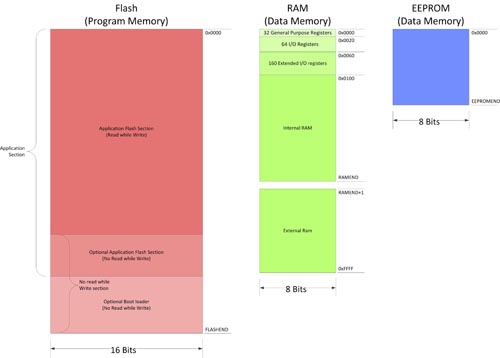Pogo Pins and Photographing LCDs
This post is a new product post, a tutorial and a behind the scenes look, all about Pogo Pins.
Pogo pins are small spring loaded pins that are used to make temporary connections to circuit boards. They are typically use for automated circuit testing or for programming Microcontrollers.
8 Breadboard Hacks
A few hacks to make bread boarding easier…
1. Hacking the power buses
The power buses on a breadboard are constructed in multiple pieces. To get continuity down the length of the bus continue reading…
ATmega168A Pulse Width Modulation – PWM
Dimming an incandescent bulb is easy. Simply adjust the current down using a potentiometer and you are done. Dimming an LED is another story entirely. When you reduce current through an LED there are unintended consequences like color shifts and dropouts. A better way is to use Pulse Width Modulation (PWM).
Extending Terminal Blocks
This week we have something that is so simple, it hardly qualifies as a tutorial, so let’s call it a “tip” and get started.
For some time we’ve stocked 2 pin and 3 pin terminal blocks. These terminal blocks have standard 5.08mm spacing, so they fit in all our development and prototyping boards. This is all good, but what do you do if you need a 4-way, 5-way or even bigger terminal block?
Soldering is Easy
Jeff Keyzer, Mitch Altman and Andie Nordgren have created a seven page comic book about soldering. The style reminds me a little of Forrest Mims’ Getting Started in Electronics.
In any event it is a great book and will be part of a bigger book “How to Make Cool Things with Microcontrollers (For People Who Know Nothing)” which will be released later this year.
The Authors have been kind enough to release the comic under a Creative Commons license (Attribution-ShareAlike), so you are free to teach with it, color it, modify it, share it with your friends, translate it, and basically do whatever you like with it!
The complete comic book is available for download here:
“Soldering is Easy” Comic Book (PDF)
Analogue to Digital Conversion on an ATmega168
Many AVR microcontrollers are capable of doing Analogue to Digital Conversion. The ATmega168 has 6 ports (8 ports on the SMD packages) that can be used for analogue input. This tutorial shows you how.
Reading and writing Atmega168 EEPROM
EEPROM (Electrically Erasable Programmable Read Only Memory) Is non-volatile memory, meaning it persists after power is removed. The ATmega168 microcontroller has 512 bytes of EEPROM which can be used to store system parameters and small amounts of data. This tutorial shows you how to read and write EEPROM.
continue reading…
AVR Eclipse Environment on Windows
In this tutorial we will show you how to setup an AVR Eclipse development environment on Windows.
continue reading…
AVR Memory Architecture
The AVR family of microcontrollers use a modified Harvard Architecture which uses 3 types of memory, most of which are on chip.
continue reading…
















